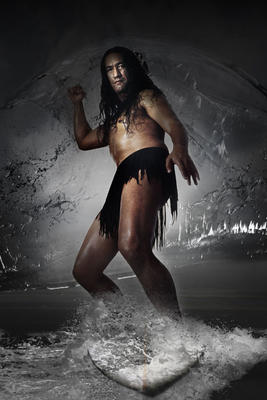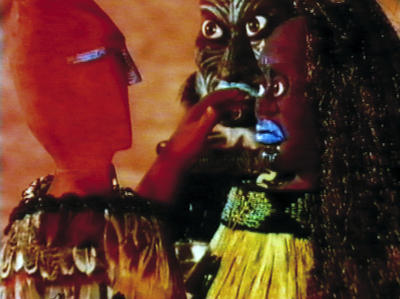Digital Marae: Dandy
-
Lisa Reihana
b.1964
Ngā Puhi, Māori
Ngāti Hine, Māori
Ngāi Tu, Māori

Title
Digital Marae: Dandy
Details
| Production Date | 2007 |
|---|---|
| Collection(s) | Collection Govett-Brewster Art Gallery, New Plymouth. Acquired with assistance from the Govett-Brewster Foundation. |
| Accession Number | 2008/4 |
| Media | Colour digital print on aluminium |
| Measurements | 2000 x 1200mm |
About
Lisa Reihana has contributed in powerful ways to multimedia and screen culture in New Zealand. In Digital Marae, one of her major ongoing projects inaugurated in 1995, Reihana explores Māori ancestral figures traditionally found on the marae, the central site of any traditional Maori community life where people congregate to discuss and debate local affairs and conduct ceremonies. The marae is imbued with strong customs and sense of place. Reihana’s life-size photographs are a contemporary take on pouwhenua, the wooden carvings found lining the interior of the wharenui or meeting house.
With the lyricism of magic realism, Reihana’s digital photographs seamlessly fuse traditional and contemporary motifs and offer new representations of Māori ancestral figures that convey the complex narratives of Māori mythology to make it accessible to global audiences. Furthermore, by incorporating varied identities Reihana’s Digital Marae echoes the desire for an inclusive contemporary marae that would interpret mythology and re-examine Maori identity itself. The photographs Dandy, Hinepukohurangi, Maui and Marakihau, all produced in 2007, reflect a significant moment in the development of Reihana’s Digital Marae, with the inclusion of male and takatāpui — a devoted partner of the same sex — and cross-gendered figures, expanding on her existing repertoire of arrestingly beautiful female forms.
The play of colour, texture, movement, costumes and props confer a distinctive character and feeling to each subject and the worlds they inhabit. The glossy finish of the digital print mounted in aluminium mimics their highly polished surfaces. Reihana sees these figures as sculptures, as physical photographic carvings representing the ancestors formally carved in pounamu and wood.
Reihana describes each of the figures as follows:
“The imaging of Dandy came from a story told to me by Victor Biddle, the talent. He tells how when the first ships began arriving in Aotearoa, takatāpui men were sent out to greet them. You need to imagine colonial vessels appearing as strange apparitions — spaceships. Māori didn’t know what these craft were, who was on them or what language they spoke. In Māoridom you look after women and children to protect the race. So I surmise that takatāpui were sent out because they were, in terms of future generations, expendable. Also, takatāpui are mediators with their own spiritual knowledge, having insight to ways of thinking beyond male and female … In response to the prevalence of colonial imagery, Dandy offers a new aesthetic code. I want to extend this discourse into an international arena. The dandies were an elite gentlemen’s class of great philosophers who heralded in new modes of 19th century thinking which in turn changed 21st century art. The play of light on the textures is important here, they draw Dandy out of the darkness.”


